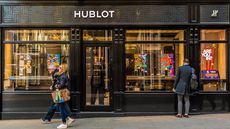Engineering profits: the British industrial champions to buy now
Move over, Germany and Sweden. There are several world-class UK engineers in profitable niches supplying a vast array of industries with vital equipment. Dr Mike Tubbs picks his favourites.

When it comes to engineering, few investors would immediately think of the UK. The "Mittelstand"of successful medium-sized engineering companies is widely known as the backbone of the German economy. There are also smaller countries Sweden being one example that boast several excellent engineering companies. But there is also a group of British engineering companies who are global leaders in their market niches, the equal of or superior to their German counterparts.
Britain's "Mittelstand"
Engineering is a broad field. This analysis excludes defence-engineering companies (in which the UK is also strong) and the many successful unlisted UK engineering businesses, such as Dyson and JCB. It concentrates on firms in electrical, electronic, mechanical, fluid, automotive and chemical engineering. They are all market-leading specialists with a global presence. In most cases well over 90% of sales stem from outside the UK and the group has a firm footprint in all three main world regions (Europe, the Americas, and Asia Pacific). Such a wide geographical spread of sales reduces the impact of a downturn in any one world region.
As leaders or strong players in their market niches, they should be able to demonstrate high profitability, defined as an operating margin (operating earnings as a proportion of sales, or EBIT/sales) of 14% or more. That gives us the nine companies in nine different sub-sectors listed in the table below. They range in size from AB Dynamics (with a market capitalisation of £0.6bn) to Halma (£7.6bn). The 2018 EBIT/sales ratio stretches from 14.1% to 39.1% for Victrex.
Subscribe to MoneyWeek
Subscribe to MoneyWeek today and get your first six magazine issues absolutely FREE

Sign up to Money Morning
Don't miss the latest investment and personal finances news, market analysis, plus money-saving tips with our free twice-daily newsletter
Don't miss the latest investment and personal finances news, market analysis, plus money-saving tips with our free twice-daily newsletter
The nine most profitable specialist engineers
We will now briefly describe what each of the nine companies does, their growth records, their dividend yields and records, and the strength of their balance sheets. We will then select the most promising on the basis of their profitability, long-term focus judged by investments in research and development (R&D) and capital expenditure (capex) and long-term profitable growth records. These nine companies are all international in outlook with the vast majority of their revenue coming from outside the UK (over 90% for all but one). All specialise in relatively small niches in which they can be world leaders.
AB Dynamics (Aim: ABDP) designs and makes equipment to test systems for the car industry, including vehicle suspensions, steering, noise and vibration. It also provides services in the areas of design, safety engineering, prototype manufacture and testing. It supplies all the major automotive manufacturers and 95% of sales are made outside the UK.
Bodycote's (LSE: BOY)expertise is in the thermal processing of metals to improve strength, durability, and corrosion resistance. It is one of the largest companies offering such services, with 92% of revenue coming from outside the UK. It also offers metal joining, surface treatments and hot isostatic pressing (HIP), which converts metal powders into strong solid components. It serves industries including renewable energy, aerospace, mining and electronics. Major camera manufacturers are among its clients.
A dividend darling
Halma (LSE: HLMA)is a safety specialist across several industries, with products including gas-detection devices, pollution gauges, water-pipeline leakage monitors, and food- and water-quality testing equipment. Halma has a very high return on capital (a key gauge of profitability) and the enviable record of having increased its dividend by 5% or more for the last 40 consecutive years.
Renishaw (LSE: RSW) has a global reputation for its precision metrology products and also boasts a small but growing precision-healthcare division (where offerings include robotic surgical systems) that has just moved into profit. The vast majority of its revenue is earned overseas (Britain contributed 5% in 2018).
Rotork (LSE: ROR)is the world-leading manufacturer of equipment to control the flow of liquids and gases. It has a worldwide network to provide local services, maintenance and upgrades. More than 94% of its revenue comes from outside the UK.
Spectris (LSE: SXS)helps companies to improve overall quality and productivity. Services include materials analysis, testing and measuring, and industrial controls. Applications include boosting the recovery rates of oil and gas, improving the performance of consumer electronics, and monitoring contamination in the pharmaceuticals and fine chemicals industries. The company combines hardware, software and services to achieve improved productivity and nearly 92% of sales are made overseas.
Spirax-Sarco (LSE: SPX)specialises in the control and management of both steam and electrical thermal energy. It is a global business with 127 operating units in 47 countries and 91% of revenue comes from outside the UK.
Fantastic plastic
Victrex (LSE: VCT)is the leading producer of PEEK polymer, a light but mechanically strong advanced polymer resistant to chemicals and wear. It is used by industries such as aerospace, automotive, energy, and electronics. It has also been used in medical implants in more than nine million people. Victrex is a global business with 98% of revenue coming from outside the UK.
Weir Group (LSE: WEIR) was formed in 1871 and has always been noted for its innovative pumps. It now supplies a wide variety of products, including pumps, centrifuges, valves and controls to the mining, infrastructure and oil and gas sectors. More than 98% of revenue comes from outside the UK.
Narrowing down the list
| Company | Sub-sector | Market cap | Sales growth 2017/2018 | EBIT/sales2017/2018 |
| AB Dynamics | Automotive | £0.6bn | +51% | 21.3% |
| Bodycote | Thermal processing | £1.5bn | +5.6% | 18.2% |
| Halma | Electronics | £7.6bn | +11.9% | 16.8% |
| Renishaw | Metrology | £2.9bn | +13.9% | 25.6% |
| Rotork | Flow-control engineering | £2.7bn | +8.3% | 18.0% |
| Spectris | Productivity engineering | £3.1bn | +5.2% | 14.1% |
| Spirax-Sarco | Energy control | £6.5bn | +15.5% | 26.0% |
| Victrex | High-performance polymers | £1.8bn | +12.3% | 39.1% |
| Weir Group | Mining and oil & gas | £4.1bn | +23.4% | 14.2% |
Narrowing down the list
Companies likely to be good investments will show a record of profitable growth and invest in R&D and capex to maintain their growth edge over competitors. They should also have strong balance sheets and a reasonable price/earnings (p/e) ratio in relation to their growth prospects. The nine companies split into two groups the first with 2020 p/e ratios in the range between 12.5 and 17, and the second with 2020 p/es from 21 to 42. The first group consists of Bodycote, Spectris, Victrex and Weir, with Victrex at the top of the group with a p/e of 16.9 and the others in the range 12.5-14.5. Victrex invests around 5% of sales in R&D and has proved able to find new applications for its advanced polymer materials and continuously improve existing ones. Recent progress has been made, for example, in dental applications with an agreement signed last year with Straumann Dental, one of the world's top companies in the sector.
Spectris also invests in the future, with about 7% of sales invested in R&D. However, Spectris has a mixed record of growth with earnings per share (EPS) dropping from 2014 to 2016 and turning negative in 2016. Bodycote's profits also fell a little in each of the two years from 2014 to 2016 and Bodycote invests little in R&D. In the more expensive group we have AB Dynamics, Halma, Renishaw, Rotork and Spirax-Sarco. The two companies in this group with high R&D investment are Renishaw (around 12% of sales) and Halma (with more than 5%). R&D as a percentage of sales is much lower for the others. AB Dynamics works for the automotive industry, which typically squeezes suppliers' margins, so in the long term the combination of low R&D and automotive customers may well reduce margins. AB's p/e of 42 does not therefore make it an attractive investment. Halma, Rotork and Spirax-Sarco are all high-quality companies, but look expensive for now.
What to buy now
Halma has just reported a 2019 pre-tax profits increase of 20% and its shares are up more than 60% since late October, with a 2020 p/e of 36. Spirax-Sarco's stock has jumped by 49% since December and now stands at a forward p/e of 31. Rotork is up rather less at 27% since early December 2018 and costs 21 times 2020 profits.
Renishaw is an interesting case, since the share price has dropped by more than 30% since last summer, giving a 2020 p/e of 24. The reason for the drop is the cyclical reduction in demand from the electronics sector and a recent fall in sales to China, probably connected with the trade war. However, Renishaw serves cyclical manufacturing industries and has recovered from previous downturns. It continues to invest heavily in R&D during downturns to give its product range a boost for when the upturn comes. And Victrex's share price is down 62% from its high last September.
In summary, the two companies to consider now are Victrex and Renishaw. I would put Halma, Spirax-Sarco and possibly Rotork on a watchlist for when their valuations are lower. All five pay dividends, with yields of 0.8% for Halma, 1.5% for Renishaw, 1.9% for Rotork, 1.1% for Spirax-Sarco and 2.8% for Victrex; include the special dividend for 2018 and the latter yield climbs to 6.8%.
For decades, Dr Mike Tubbs worked on the 'inside' of corporate giants such as Xerox, Battelle and Lucas. Working in the research and development departments, he learnt what became the key to his investing. Knowledge which gave him a unique perspective on the stock markets.
Dr Tubbs went on to create the R&D Scorecard which was presented annually to the Department of Trade & Industry and the European Commission. It was a guide for European businesses on how to improve prospects using correctly applied research and development.
-
 Barclays warns of significant rise in social media investment scams
Barclays warns of significant rise in social media investment scamsInvestment scam victims are losing an average £14k, with 61% of those falling for one over social media. Here's how to spot one and keep your money safe
By Oojal Dhanjal Published
-
 Over a thousand savings accounts now offer inflation-busting rates – how long will they stick around?
Over a thousand savings accounts now offer inflation-busting rates – how long will they stick around?The rate of UK inflation slowed again in March, boosting the opportunity for savers to earn real returns on cash in the bank. But you will need to act fast to secure the best deals.
By Katie Williams Published
-
 Invest in space: the final frontier for investors
Invest in space: the final frontier for investorsCover Story Matthew Partridge takes a look at how to invest in space, and explores the top stocks to buy to build exposure to this rapidly expanding sector.
By Dr Matthew Partridge Published
-
 Invest in Brazil as the country gets set for growth
Invest in Brazil as the country gets set for growthCover Story It’s time to invest in Brazil as the economic powerhouse looks set to profit from the two key trends of the next 20 years: the global energy transition and population growth, says James McKeigue.
By James McKeigue Published
-
 5 of the world’s best stocks
5 of the world’s best stocksCover Story Here are five of the world’s best stocks according to Rupert Hargreaves. He believes all of these businesses have unique advantages that will help them grow.
By Rupert Hargreaves Published
-
 The best British tech stocks from a thriving sector
The best British tech stocks from a thriving sectorCover Story Move over, Silicon Valley. Over the past two decades the UK has become one of the main global hubs for tech start-ups. Matthew Partridge explains why, and highlights the most promising investments.
By Dr Matthew Partridge Published
-
 Could gold be the basis for a new global currency?
Could gold be the basis for a new global currency?Cover Story Gold has always been the most reliable form of money. Now collaboration between China and Russia could lead to a new gold-backed means of exchange – giving prices a big boost, says Dominic Frisby
By Dominic Frisby Published
-
 How to invest in videogames – a Great British success story
How to invest in videogames – a Great British success storyCover Story The pandemic gave the videogame sector a big boost, and that strong growth will endure. Bruce Packard provides an overview of the global outlook and assesses the four key UK-listed gaming firms.
By Bruce Packard Published
-
 How to invest in smart factories as the “fourth industrial revolution” arrives
How to invest in smart factories as the “fourth industrial revolution” arrivesCover Story Exciting new technologies and trends are coming together to change the face of manufacturing. Matthew Partridge looks at the companies that will drive the fourth industrial revolution.
By Dr Matthew Partridge Published
-
 Why now is a good time to buy diamond miners
Why now is a good time to buy diamond minersCover Story Demand for the gems is set to outstrip supply, making it a good time to buy miners, says David J. Stevenson.
By David J Stevenson Last updated